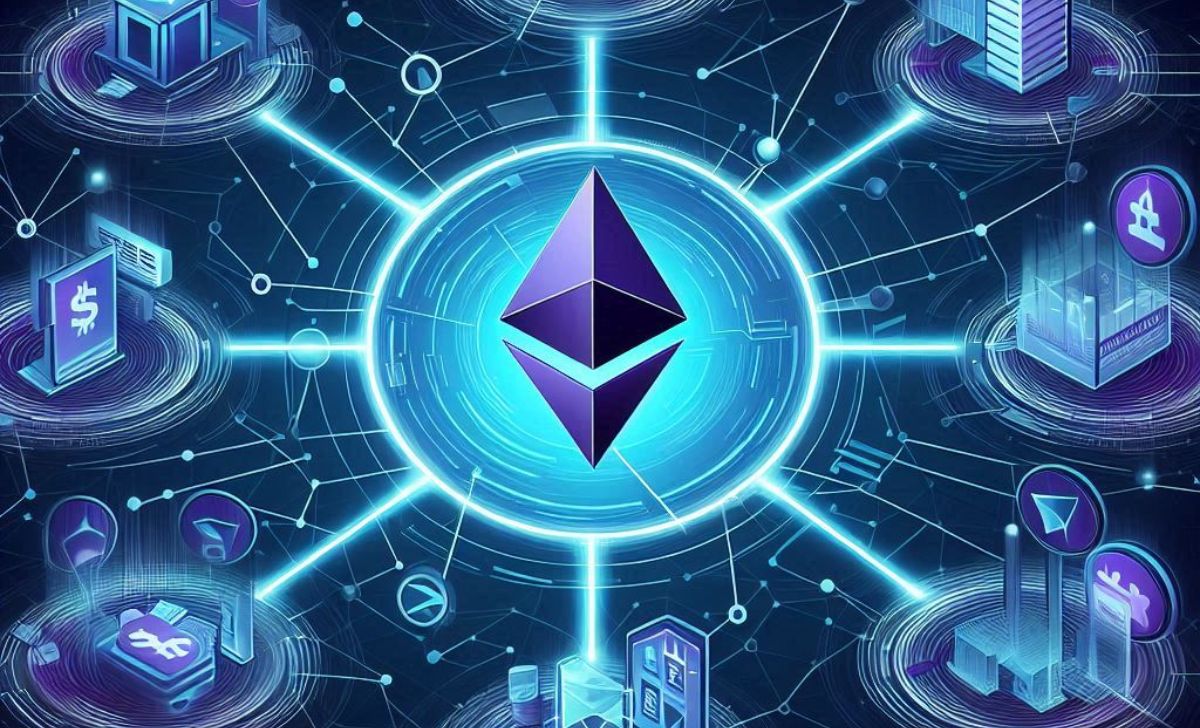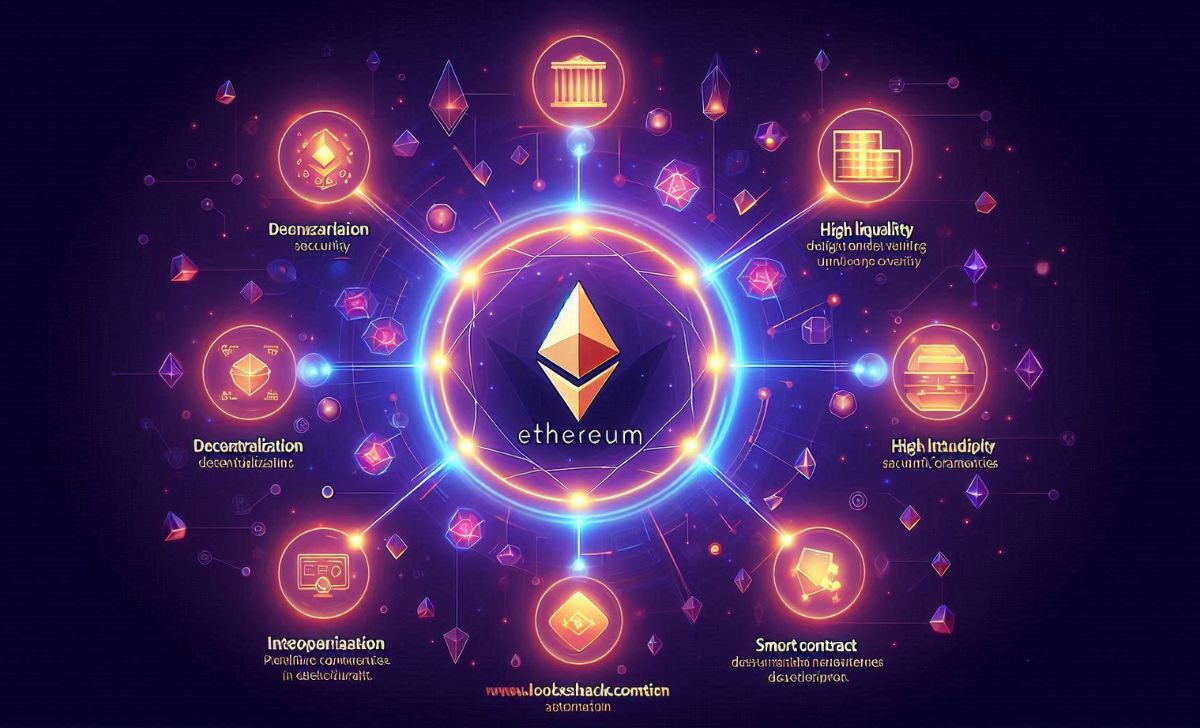Ethereum in DeFi, as the backbone of decentralized finance, is revolutionizing the financial world. You might be wondering about its role, advantages, and challenges. The following article from TopCoin9 will help you gain a deeper understanding.
Ethereum’s Role in DeFi: The Backbone of Financial Innovation

Ethereum is more than just a cryptocurrency; it serves as the core infrastructure for decentralized financial applications. Its smart contract capabilities enable trustless transactions, making financial services more accessible and efficient.
Smart Contracts and Automation in DeFi
Ethereum smart contracts are the backbone of the Ethereum DeFi ecosystem, allowing developers to create decentralized applications (DApps) that operate without human intervention. These contracts execute transactions automatically when conditions are met, eliminating the need for intermediaries.
With smart contracts, DeFi users can engage in lending, borrowing, trading, and staking without relying on traditional banking institutions. This automation reduces costs and increases efficiency across DeFi platforms.
While smart contracts provide significant advantages, their security is crucial, as vulnerabilities can lead to financial losses. Next, let’s explore the key components of Ethereum’s DeFi ecosystem.
Key Components of the Ethereum DeFi Ecosystem
The Ethereum DeFi ecosystem comprises various applications that offer financial services in a decentralized manner. These include:
- Decentralized Exchanges (DEXs): Platforms like Uniswap and Curve allow users to trade cryptocurrencies without intermediaries.
- Lending and Borrowing Platforms: Aave and Compound enable peer-to-peer lending and borrowing, reducing reliance on traditional banks.
- Stablecoins and Payments: DAI and USDC provide price stability for transactions within the DeFi space.
- Yield Farming and Staking: Users earn rewards by providing liquidity or staking tokens in DeFi protocols.
With these fundamental components, Ethereum continues to be the leading blockchain for DeFi applications. Now, let’s examine the advantages that make Ethereum the preferred choice for DeFi development.
Advantages of Ethereum in DeFi

Ethereum’s dominance in DeFi is not by chance—it offers unique advantages that make it the most reliable blockchain for decentralized financial applications.
Smart Contract Capabilities and Security
Ethereum pioneered smart contracts, setting the standard for secure and efficient decentralized applications. These contracts provide transparency, ensuring users have full visibility into how transactions are executed.
The security of Ethereum-based DeFi applications is further enhanced by its decentralized nature. Unlike centralized financial systems, where a single point of failure can lead to data breaches, Ethereum distributes its data across multiple nodes, reducing risks.
While Ethereum’s security is a major strength, its large ecosystem also plays a critical role in its success. Let’s explore how Ethereum’s network effect benefits DeFi projects.
Ethereum’s Large and Established DeFi Ecosystem
The Ethereum DeFi ecosystem includes thousands of projects, developers, and investors, creating a robust network effect. This strong community ensures continuous development, liquidity, and innovation within the DeFi space.
Ethereum’s ecosystem benefits from:
- Extensive Developer Support: Thousands of developers actively build and improve DeFi applications.
- Deep Liquidity: Large pools of capital flow into Ethereum-based DeFi projects, ensuring smooth transactions.
- Interoperability: Many DeFi applications can seamlessly integrate, allowing users to move assets between platforms.
Despite these advantages, Ethereum still faces challenges that could impact its long-term role in DeFi. Next, we’ll look at some key limitations.
Challenges Facing Ethereum in DeFi

While Ethereum leads the DeFi space, it faces obstacles that could affect its future growth. Addressing these issues is crucial for maintaining its position as the backbone of decentralized finance.
Scalability Issues and High Gas Fees
One of the biggest challenges for Ethereum in DeFi is network congestion, leading to high transaction costs. As DeFi adoption increases, Ethereum struggles to process transactions quickly and affordably.
- Ethereum gas fees: Users often face expensive fees, making small transactions impractical.
- Slow processing times: High demand can cause delays in transaction confirmation.
Solutions such as Ethereum 2.0 and Layer 2 scaling technologies aim to resolve these issues.
While scalability is a major challenge, security risks in smart contracts also pose a significant threat to DeFi users. Let’s take a closer look at these risks.
Security Risks and Smart Contract Vulnerabilities
Although Ethereum’s security is strong, smart contracts remain susceptible to bugs and exploits. Several Ethereum DeFi projects have suffered from attacks, leading to millions of dollars in losses.
- Code vulnerabilities: Errors in smart contract programming can be exploited by hackers.
- Flash loan attacks: DeFi protocols have been targeted through rapid, uncollateralized loans that manipulate markets.
Regular audits and improved security practices are essential for reducing these risks in the Ethereum ecosystem.
Despite these challenges, Ethereum continues to innovate. In the next section, we’ll explore how Ethereum 2.0 and Layer 2 solutions will enhance its DeFi capabilities.
The Future of Ethereum in DeFi

Ethereum is actively working on solutions to maintain its dominance in the DeFi space. Several upgrades and innovations will shape the future of Ethereum DeFi ecosystem.
Ethereum 2.0: The Shift to Proof of Stake (PoS)
Ethereum 2.0 aims to improve scalability, security, and sustainability by transitioning from Proof of Work (PoW) to Proof of Stake (PoS). This upgrade will:
- Reduce gas fees: More efficient transaction processing will lower costs for DeFi users.
- Increase transaction speed: The network will handle more transactions per second.
- Enhance energy efficiency: PoS consumes less energy compared to PoW, making Ethereum more sustainable.
While Ethereum 2.0 is a major step forward, Layer 2 solutions also play a critical role in improving DeFi applications.
Layer 2 Solutions: Optimizing Ethereum DeFi Projects
Ethereum Layer 2 projects help scale Ethereum by processing transactions off-chain while maintaining security. Technologies like Optimism, Arbitrum, and zk-Rollups offer:
- Faster transactions: Layer 2 networks reduce congestion on the Ethereum mainnet.
- Lower fees: Users can interact with DeFi applications at a fraction of current costs.
- Greater accessibility: More users can participate in DeFi without worrying about high transaction costs.
As Ethereum 2.0 and Layer 2 solutions improve the blockchain’s efficiency, Ethereum will continue to drive the future of decentralized finance.
Ethereum in DeFi is the foundation of decentralized finance, driving innovation and financial inclusion worldwide. Ethereum in DeFi continues to expand, empowering users with a secure and transparent ecosystem. Visit TopCoin9 to learn more about Ethereum in DeFi and stay updated on the latest crypto insights!

As a certified blockchain security expert with over 8 years in cybersecurity, James Anderson specializes in auditing smart contracts and identifying vulnerabilities in DeFi protocols. His expertise ensures that TopCoin9 delivers reliable insights on blockchain security and risk management.
Email: [email protected]












